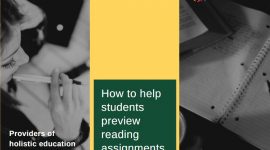The demands of educating can feel overpowering every now and then, and it can turn out to be anything but difficult to dismiss the most significant explanation of why we instruct: the students. Every student is exceptional and has the right to be acknowledged for their remarkable qualities. By building up a framework at Ecole Globale International we send positive notes home all the time, I, as a teacher, have discovered that I keep my students’ triumphs in the front of my psyche, and unpleasant days are immediately placed into viewpoint—for the students, their families, and me.
Most educators are required to communicate home when a student performs inadequately in the school—scholastically or otherwise. My own education has decidedly become through my deliberately reaching families when students perform well.
Tracking Communication for each Student
Toward the start of each school year, setting up another evaluation book, I set up a graph posting each student one after another in order by the last name. In the segments, I list the dates when I reach families, the strategy (email, face to face meeting, or call), and the explanation behind communication. Consistently, at whatever point I have to contact a family, I make a point to enter it into the outline, with the objective of reaching every family with a positive note home in any event.
The reason why Ecole Globale is considered as the best boarding school is that they regularly communicate with families who are new with the school. As far as I can tell, these families have some tension about their child being in another condition, and they feel mitigated when they hear that the year is working out in a right way from a grown-up’s point of view. It additionally causes them to have communication at the school if there should arise an occurrence of inquiries later on. As the year advances, set up new objectives.
Positive Moments
My practices in positive communication started when sending home messages of concern, and started to burden my own soul of hopefulness. I understood that in the event that I sent a positive email each time I sent an email of concern, I could pull together my vitality into perceiving the students who made the day of enjoyment. Presently, years after that acknowledgement, I attempt to send positive messages before the worries emerge, so every family has a positive story to tell about their child’s school understanding.
The absolute and evident communications are the simplest. When a student excels on a troublesome thing like a paper or a test, I communicate with their family. Yet, appraisals are, by all accounts, not the only chance to send home appreciation. Communication can be about a student exceeding expectations in delicate abilities: intervening a difference in group work, blending up with a desolate student during class, or demonstrating sympathy to a schoolmate having an unpleasant day. Their conduct need not be excellent; I have sent notes about students routinely coming into the classroom and following methodology, dependably finishing schoolwork, and handling troublesome undertakings with an inspirational demeanor.
To ensure that no student has been communicated just for negative reasons, I code the text styles of the graph. Afterwards, when I open the outline, I can rapidly check for hues and check whether I have a positive note for a development, normally a little while after the first communication. I set aside that effort to watch students and note any positive moments so that I can send communication home again with a positive or a development note.
By defining a deliberate objective to email home with a constructive, individual account, I ensure that no student remains undetectable under my watch. As I look through my rundown every week, I can see which students’ families haven’t been reached, and I am ready to house those connections and create them deliberately.
Again and again, students who get the most consideration are the individuals who are relationship-chasing with negative practices, for example, carrying on or failing to meet expectations on evaluations. The remainder of the families probably won’t get notification from the school the whole year, despite their child’s extraordinary mentality and hard-working attitude. Purposeful chase permits me to perceive those students for the propensities they bring.
Throughout deliberate watch and commending the perspectives and practices of my students, I’ve had the option to manufacture positive network between the school and home. In addition to the fact that parents appreciate accepting a look into their child’s daily life (particularly when discussion may be short at home), yet they value their kid. Realizing that somebody at the school is looking past the measures, reviewing, and agendas to consider each to be as an individual goes far in building a compatibility between the two most significant groups in instruction: home and school.









